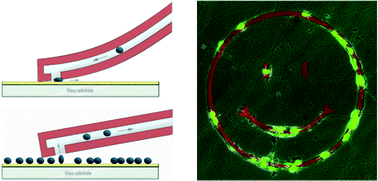Controlled single-cell deposition and patterning by highly flexible hollow cantilevers†
Abstract
Single-cell patterning represents a key approach to decouple and better understand the role and mechanisms of individual cells of a given population. In particular, the bottom-up approach of engineering neuronal circuits with a controlled topology holds immense promises to perceive the relationships between connectivity and function. In order to accommodate these efforts, highly flexible SU-8 cantilevers with integrated microchannels have been fabricated for both additive and subtractive patterning. By directly squeezing out single cells onto adhesive surfaces, controlled deposition with a spatial accuracy of 5 μm could be achieved, while subtractive patterning has been realized by selective removal of targeted single cells. Complex cell patterns were created on substrates pre-patterned with cell-adhesive and repulsive areas, preserving the original pattern geometry for long-term studies. For example, a circular loop with a diameter of 530 μm has been realized using primary hippocampal neurons, which were fully connected to their respective neighbors along the loop. Using the same cantilevers, the versatility of the technique has also been demonstrated via in situ modification of already mature neuronal cultures by both detaching individual cells of the population and adding fresh ones, incorporating them into the culture.



 Please wait while we load your content...
Please wait while we load your content...